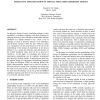Free Online Productivity Tools
i2Speak
i2Symbol
i2OCR
iTex2Img
iWeb2Print
iWeb2Shot
i2Type
iPdf2Split
iPdf2Merge
i2Bopomofo
i2Arabic
i2Style
i2Image
i2PDF
iLatex2Rtf
Sci2ools
WSC
1998
1998
Interactive Implementation of Optimal Simulation Experiment Designs
An attractive feature of many simulation packages is their availability on desktop computers and their potential for allowing the user to run a simulation model under different conditions in a highly interactive way. Such a way of studying a system is attractive because of its immediacy and the direct control it offers the user. However, partly as a consequence of this, good practice in the use of the methodology of the design of experiments is not always followed. As a result the efficiency and effectiveness of the overall simulation study may not be as good as it should be. In this paper we investigate how design of experiments methodology can be explicitly incorporated into interactive desktop studies. In particular we show how the optimal design of experiments methodology proposed by Cheng and Kleijnen (1998) for studying queues with highly heteroscedastic output can be used to provide a front-end advisory interface for controlling and conducting the study of an actual system. To ...
Modeling And Simulation | Overall Simulation Study | Simulation Model | Simulation Package | WSC 1998 |
Related Content
| Added | 01 Nov 2010 |
| Updated | 01 Nov 2010 |
| Type | Conference |
| Year | 1998 |
| Where | WSC |
| Authors | Russell C. H. Cheng, John D. Lamb |
Comments (0)

